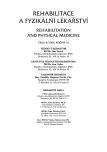Locomotor Interventions in the Therapy of Food Intake Disorders
Authors:
H. Dušková; D. Pavlů
Authors‘ workplace:
Katedra fyzioterapie FTVS UK, Praha
vedoucí katedry doc. PaedDr. D. Pavlů, CSc.
Published in:
Rehabil. fyz. Lék., 16, 2009, No. 4, pp. 165-169.
Category:
Original Papers
Overview
The contribution summarizes present knowledge referring to the importance of locomotor intervention in the therapy of food intake disorders. The authors review the approaches recommended in Astralia, Canada, Japan, U.S.A., Germany and Belgium, refer to their basic principles and draw attention to the fact that there are still missing unified recommendations for the application of locomotor intervention, although efficiency of various procedures has been already proved.
Key words:
disorders of food intake, locomotor intervention, efficiency
Sources
1. AGRAS, W. S., WERNE, J.: Behavior therapy in anorexia nervosa: A data-based approach to the question. 1978. In Beumont et al.: Excessive physical aktivity in dieting disorder patiens: Proposals for a supervised exercise program. International Journal of Eating Disorders, 15, 1994.
2. BEUMONT, P. J. V., ARTHUR, B., RUSSELL, J. D., TOUYZ, S. W.: Excessive physical aktivity in dieting disorder patiens: Proposals for a supervised exercise program. International Journal of Eating Disorders, 15, 1994.
3. BOUDETTE, R.: Question & Ansver: Yoga in the treatement of disordered eating and body Image disturbance. How can the practice of yoga be helpful in recovery from an eating disorder? Eating Disorders. 14, 2006.
4. DAUBENMIER, J.: The relationship of yoga, body awareness, and body responsiveness to self-objectfication and disordered eating. Psychol. Women, 29, 2005.
5. DENOON, D. J.: Controlled exercise may help anorexia. Weight gain seen in anorexia patients aftersSafe exercise. WebMD Health News [online]. 2004 [cit. 5. 4. 2009]. Dostupné na WWW: < webmd.com/mental-health/anorexia-nervosa/news/20040723/controlled-exercise-may-help-anorexia>
6. EPLING, W. F., PIERCE, W. D., STEFAN, L.: A theory of activity based anorexia. International Journal of Eating Disorders, 3, 1983.
7. FRIEDERICH, H. CH., SCHILD, S., WILD, B., DE ZWAAN, M., QUENTER, A., HERZOG, W., ZIPFEL, S.: Treatment outcome in people with subthreshold compared with full-syndrome binge eating disorder. Obesity, 15, 2, 2007.
8. GULL, W. W.: Anorexia Nervosa. 1964. In Beumont et al.: Excessive physical aktivity in dieting disorder patiens: Proposals for a supervised exercise program. International Journal of Eating Disorders, 15, 1994.
9. JANET, P.: The major symptoms of hysteria. 1929. In Beumont et al.: Excessive physical aktivity in dieting disorder patiens: Proposals for a supervised exercise program. International Journal of Eating Disorders, 15, 1994.
10. KRISTELLER, J., HALLET, C.: An exploratory study of a meditation-based intervention for binge eating disorder. 1999. In Mitchell et al.: Innovative interventions for disordered eating: Evaluating disonance-based and yoga interventions. International Journal of Eating Disorders, 40, 2007.
11. LASÉGUE, C. H.: De l`anorexie hysterique [Hysterical anorexia]. 1964. In Beumont et al.: Excessive physical aktivity in dieting disorder patiens: Proposals for a supervised exercise program. International Journal of Eating Disorders, 15, 1994.
12. MITCHELL, K. S., MAZZEO, S. E., RAUSCH, S. M., COOKE, K. L.: Innovative Interventions for Disordered Eating: Evaluating Disonance-Based and Yoga Interventions. International Journal of Eating Disorders, 40, 2007.
13. MAVISSKALIAN, M.: Anorexia nervosa treated with response prevention and prolonged exposure. Behavior Research and Therapy. 20, 1982.
14. PROBST, M.: Přednáška: Physiotherapy and eating disorders, international course on health care issues. Belgie, 2002.
15. PROBST, M.: Přednáška: Body Image. Praha, 2006.
16. REIBEL, D., GREESON, J., BRAINARD, G., ROSENZWIG, S.: Mindfulness-based stress reduction and health-related duality of life in a heterogenous patient population. 2001. In Mitchell et al.: Innovative interventions for disordered eating: Evaluating disonance-based and yoga interventions. International Journal of Eating Disorders, 40, 2007.
17. RUSSELL, J. D., BEUMONT, P. J. V.: The endocrinology of anorexia nervosa. 1987. In Beumont et al.: Excessive physical aktivity in dieting disorder patiens: Proposals for a supervised exercisepProgram. International Journal of Eating Disorders, 15, 1994.
18. THIEN, V., THOMAS, A., MARKIN, D., BIRMINGHAM, C. L.: Pilot study of a graded exercise program for the treatment of anorexia nervosa. International Journal of Eating Disorders. 28, 2000.
19. TOKUMURA, M., YOSHIBA, S., TANAKA, T., NANRI, S., WATANABE, H.: Prescribed exercise training improves exesrcise kapacity of convalescent children and adolescent with anorexia nervosa. European Journal of Pediatry. 162, 2003.
20. TOUYZ, S. W., LENNERTS, W., ARTHUR, B., BEUMONT, P. J. V: Anaerobic exercise as a adjunkt to refeeding patiens with anorexia nervosa: Does it kompromise weight gain? Eating Disorder Review. 1993.
21. TOUYZ, S. W.; BEUMONT, P. J. V., GLAUN, D., PHILLIP, T., COWIE, I.: A comparison of lenient and strict operantvconditioning programmes in refeeding patiens with anorexia nervosa. British Journal of Psychiatry, 144, 1984.
22. VANDEREYCKEN, W., PROBST, M., MEERMAN, R.: An experimental video-confrotation procedure as a therapeutic technique and a research tool in the treatment of eating disorders. International Journal of Eating Disorders, 2, 1988.
Labels
Physiotherapist, university degree Rehabilitation Sports medicineArticle was published in
Rehabilitation & Physical Medicine

2009 Issue 4
- Hope Awakens with Early Diagnosis of Parkinson's Disease Based on Skin Odor
- Deep stimulation of the globus pallidus improved clinical symptoms in a patient with refractory parkinsonism and genetic mutation
Most read in this issue
- Hamstring Injuries – Possible Kinds of Treatment and Therapeutic Procedures in Relation to Individual Phase of the Healing Process
- Extracorporeal Shockwave Therapy of Musculoskeletal System
- First Experience with the Pain Gone Apparatus
- Locomotor Interventions in the Therapy of Food Intake Disorders
